Structural Reinforcement Effect of a Flexible Strain Sensor Integrated with Pneumatic Balloon Actuators for Soft Microrobot Fingers
Abstract
:1. Introduction
2. Materials and Methods
2.1. Fabrication Process of a Liquid Metal-Based Sensor for Use with a PBA
2.2. Measurement Setup for Sensor Evaluation
2.3. Estimation of the Gauge Factor
3. Results
3.1. Fabrication Results of Liquid Metal-Based Strain Sensor Integrated Into Microfinger with PBAs
3.2. Influence of Inflatable Deformation by PBA
3.3. Parylene C Deposition Into Microchannel for Structural Reinforcement of Liquid Metal-Based Sensor
4. Discussion
4.1. Effect of Parylene C Deposition Into Microchannel for Structual Reinforcement
4.2. Effect of Parylene C Deposition into Microchannel for Liquid Metal Introduction
5. Conclusions
Author Contributions
Funding
Institutional Review Board Statement
Informed Consent Statement
Data Availability Statement
Acknowledgments
Conflicts of Interest
References
- Rogers, J.A.; Someya, T.; Huan, Y. Materials and mechanics for stretchable electronics. Science 2010, 327, 1603–1607. [Google Scholar] [CrossRef] [PubMed] [Green Version]
- Kim, J.; Campbell, A.S.; Esteban-Fernández de Ávila, B.; Wang, J. Wearable biosensors for healthcare monitoring. Nat. Biotechnol. 2019, 37, 389–406. [Google Scholar] [CrossRef] [PubMed]
- Morris, D.; Coyle, S.; Wu, Y.; Lau, K.T.; Wallace, G.; Diamond, D. Bio-sensing textile based patch with integrated optical detection system for sweat monitoring. Sens. Actuators B Chem. 2009, 139, 231–236. [Google Scholar] [CrossRef] [Green Version]
- Lee, H.; Choi, T.K.; Lee, Y.B.; Cho, H.R.; Ghaffari, R.; Wang, L.; Choi, H.J.; Chung, T.D.; Lu, N.; Hyeon, T.; et al. A graphene-based electrochemical device with thermoresponsive microneedles for diabetes monitoring and therapy. Nat. Nanotechnol. 2016, 11, 566–572. [Google Scholar] [CrossRef] [PubMed]
- Lee, H.; Song, C.; Hong, Y.S.; Kim, M.S.; Cho, H.R.; Kang, T.; Shin, K.; Choi, S.H.; Hyeon, T.; Kim, D.-H. Wearable/disposable sweat-based glucose monitoring device with multistage transdermal drug delivery module. Sci. Adv. 2017, 3, e1601314. [Google Scholar] [CrossRef] [PubMed] [Green Version]
- De Volder, M.; Reynaerts, D. Pneumatic and hydraulic microactuators. J. Micromech. Microeng. 2010, 20, 043001. [Google Scholar] [CrossRef] [Green Version]
- Gorissen, B.; Reynaerts, D.; Konishi, S.; Yoshida, K.; Kim, J.; De Volder, M. Elastic inflatable actuators for soft robotic applications. Adv. Mater. 2017, 29, 1604977. [Google Scholar] [CrossRef] [PubMed]
- Konishi, S.; Kawai, F.; Cusin, P. Thin flexible end-effector using pneumatic balloon actuator. Sens. Actuators A 2001, 89, 28–35. [Google Scholar] [CrossRef]
- Jeong, O.; Konishi, S. All PDMS pneumatic microfinger with bidirectional motion and its application. IEEE J. Microelectromech. Syst. 2006, 15, 896–903. [Google Scholar] [CrossRef]
- Konishi, S.; Shimomura, S.; Tajima, S.; Tabata, S. Implementation of soft microfingers for a hMSC aggregate manipulation system. Microsyst. Nanoeng. 2016, 2, 15048. [Google Scholar] [CrossRef] [PubMed]
- Konishi, S.; Hirata, A. Flexible Temperature Sensor Integrated with Soft Pneumatic Microactuators for Functional Microfingers. Sci. Rep. 2019, 9, 15634. [Google Scholar] [CrossRef] [PubMed] [Green Version]
- Konishi, S.; Sawano, S.; Kusuda, S.; Sakakibara, T. Fluid-Resistive Bending Sensor Compatible with a Flexible Pneumatic Balloon Actuator. J. Robot. Mechatron. 2008, 20, 436–440. [Google Scholar] [CrossRef]
- Lee, Y.; Bae, S.; Jang, H.; Jang, S.; Shu, S.; Sim, S.H.; Song, Y.I.; Hong, B.H.; Ahn, J.H. Wafer-Scale synthesis and transfer of graphene films. Nano Lett. 2010, 10, 490–493. [Google Scholar] [CrossRef] [PubMed] [Green Version]
- Das, N.C.; Chaki, T.K.; Khastgir, D. Effect of axial stretching on electrical resistivity of short carbon fibre and carbon black filled conductive rubber composites. Polym. Int. 2002, 51, 156–163. [Google Scholar] [CrossRef]
- Otake, S.; Konishi, S. Integaration of flexible strain sensor using liquid metal into soft micro-actuator. In Proceedings of the IEEE International Confernce on Micro Electro Mechacnial Systems, Belfast, UK, 21–25 January 2018; pp. 571–574. [Google Scholar]
- Cerratt, A.P.; Michaud, H.O.; Lacour, S.P. Elastomeric electronic skin for prosthetic tactile sensation. Adv. Funct. Mater. 2015, 25, 2287–2295. [Google Scholar] [CrossRef]
- Kim, M.; Alrowais, H.; Brand, O. All-soft physical and chemical microsystems based on liquid metal for wearable electronics applications. In Proceedings of the IEEE International Conference on Micro Electro Mechacnial Systems, Las Vegas, NV, USA, 22–26 January 2017; pp. 31162–31165. [Google Scholar]
- Hirsch, A.; Dejace, L.; Michaud, H.O.; Lacour, S.P. Harnessing the Rheological Properties of Liquid Metals to Shape Soft Electronic Conductors for Wearable Applications. Acc. Chem. Res. 2019, 52, 534–544. [Google Scholar] [CrossRef] [PubMed]
- Otake, S.; Mori, F.; Konishi, S. Common flexible channel structure for integration of three-axis force sensor and soft micro actuator. In Proceedings of the IEEE International Conference on Micro Electro Mechacnial Systems, Seoul, Korea, 27–31 January 2019; pp. 652–655. [Google Scholar]
- Otake, S.; Konishi, S. Integration and design optimization of flexible strain sensor using liquid metal for soft pneumatic actuator. In Proceedings of the 35th Sensor symposium, Sapporo, Japan, 30 October–1 November 2018. [Google Scholar]
- Patrick, R.; Stieglitz, T. The effects of annealing on mechanical, chemical, and physical properties and structural stability of Parylene, C. Biomed. Microdevices 2013, 15, 727–735. [Google Scholar] [CrossRef]
- Johnston, I.D.; McCluskey, D.K.; Tan, C.K.L.; Tracey, M.C. Mechanical characterization of bulk Sylgard 184 for microfluidics and microengineering. J. Micromech. Microeng. 2014, 24, 035017. [Google Scholar] [CrossRef]
- Liu, T.; Sen, P.; Kim, C.J. Characterization of nontoxic liquid-metal alloy galinstan for applications in microdevices. IEEE J. Microelectromech. Syst. 2012, 21, 443–450. [Google Scholar] [CrossRef] [Green Version]

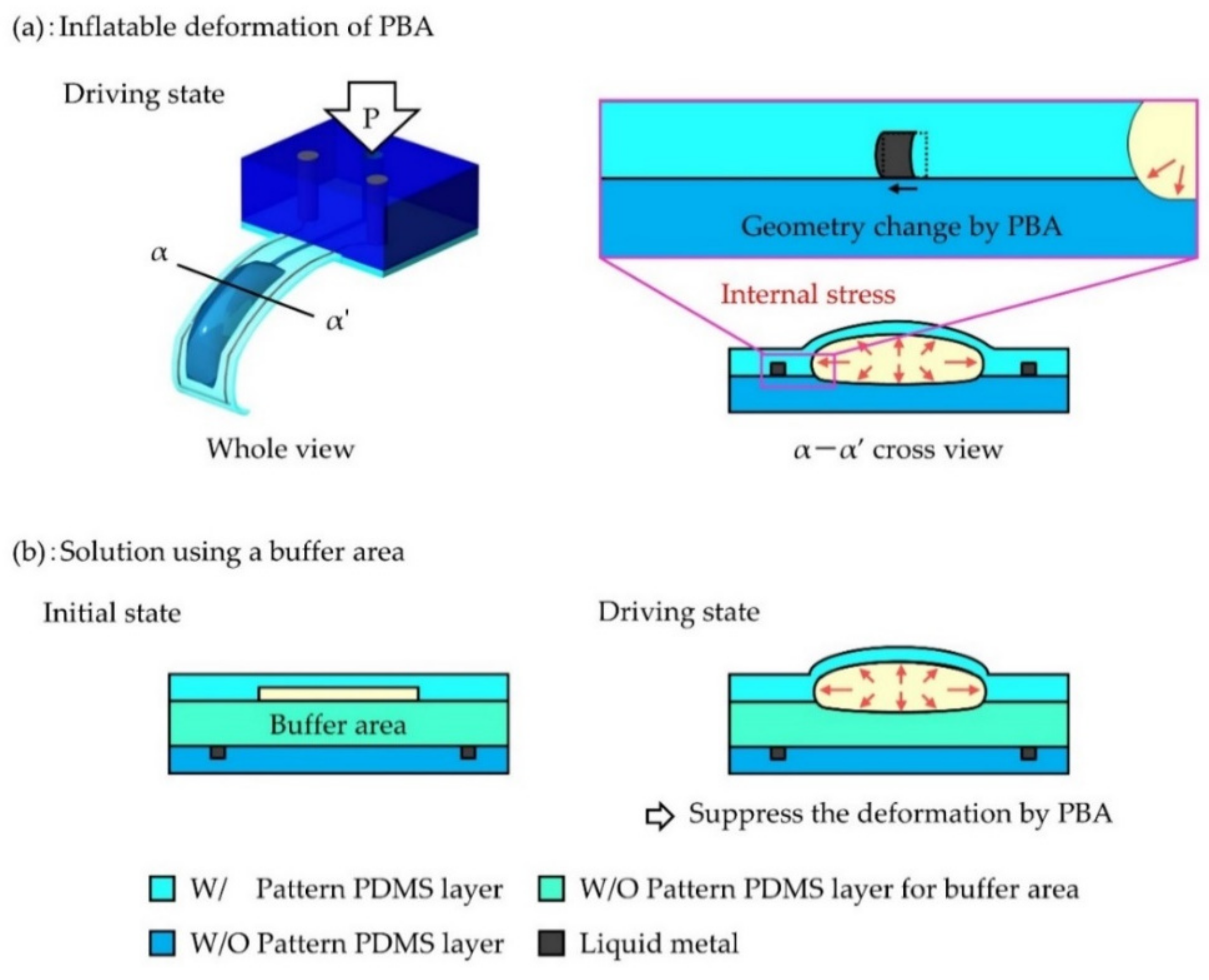
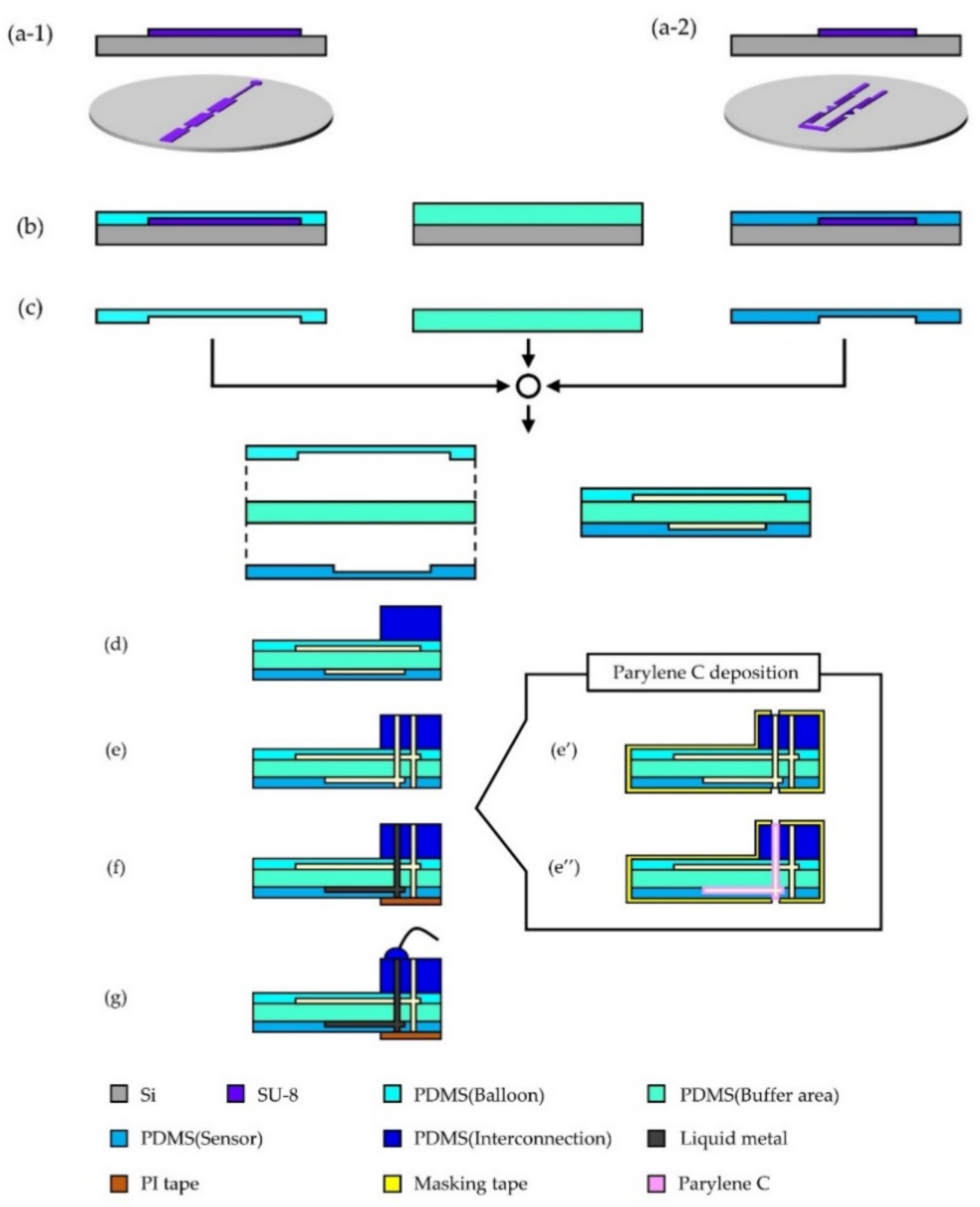

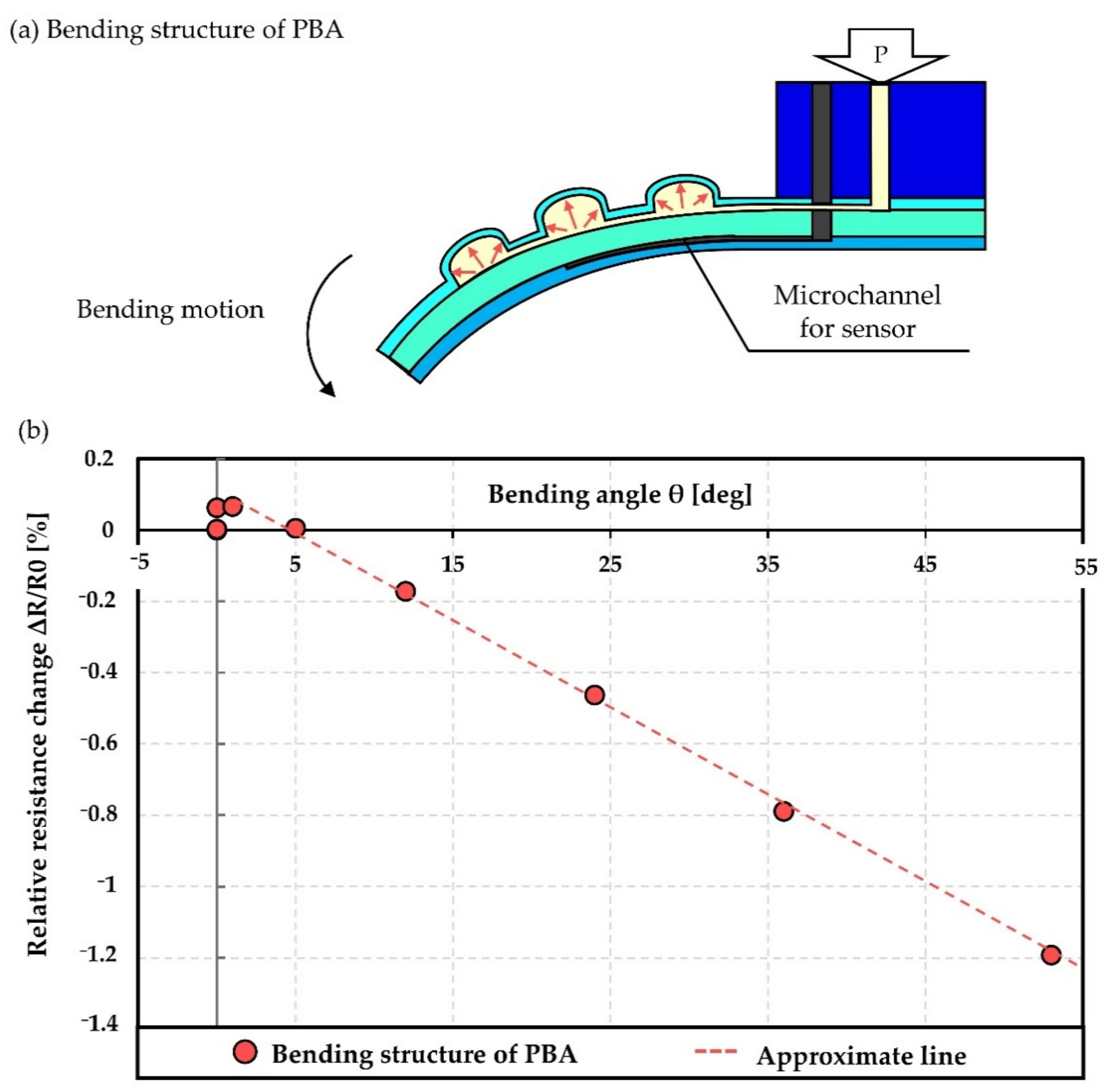
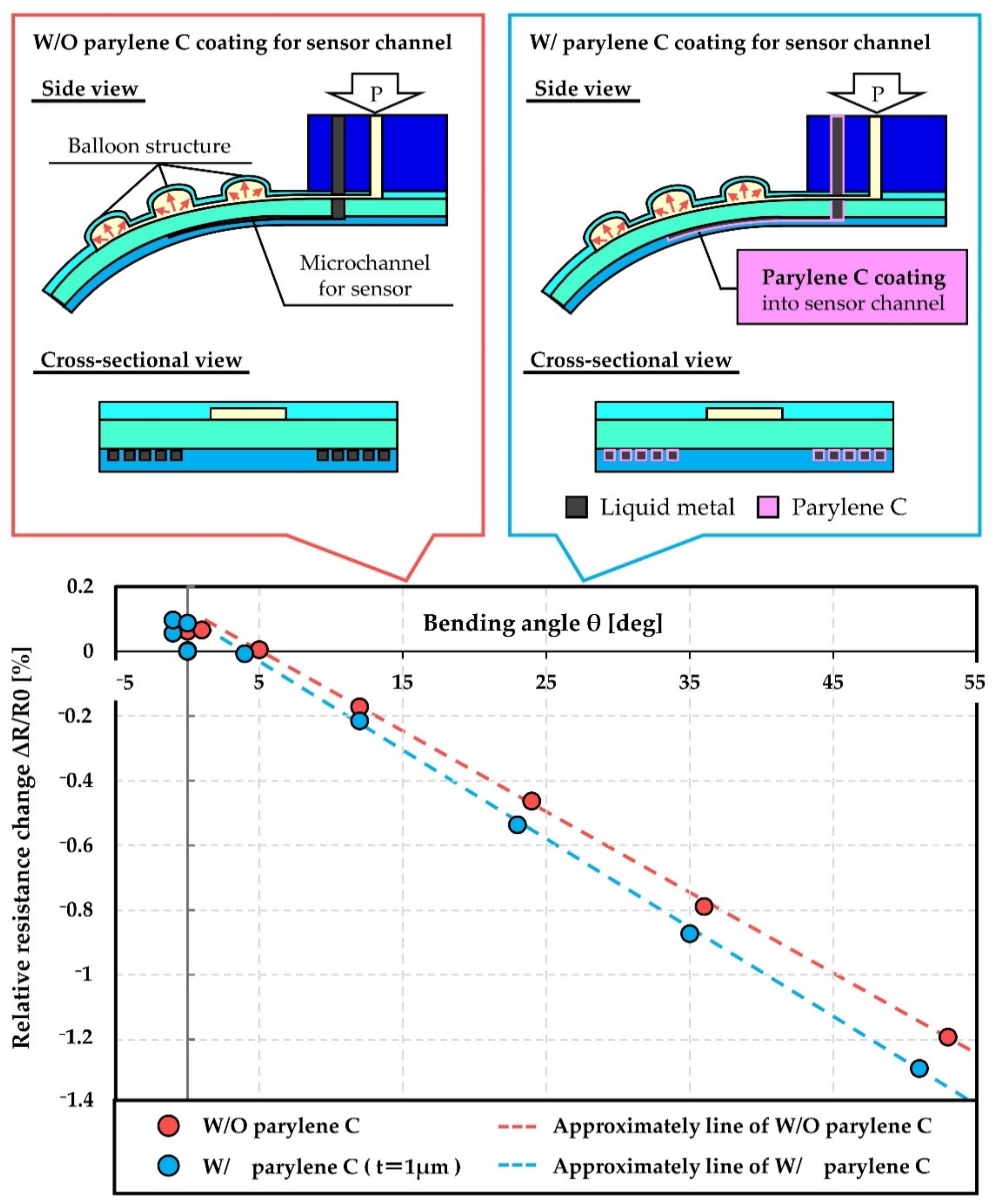
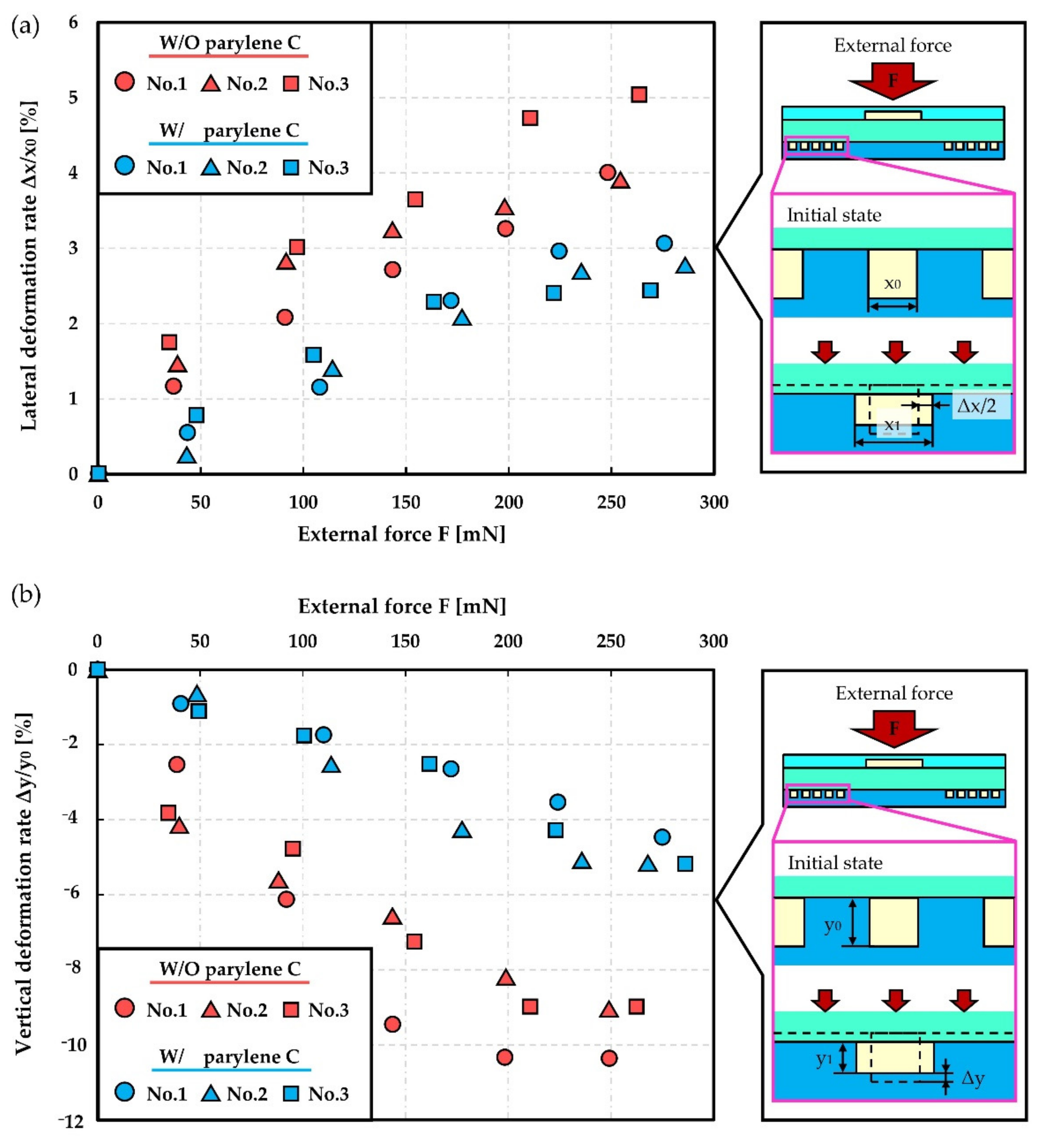
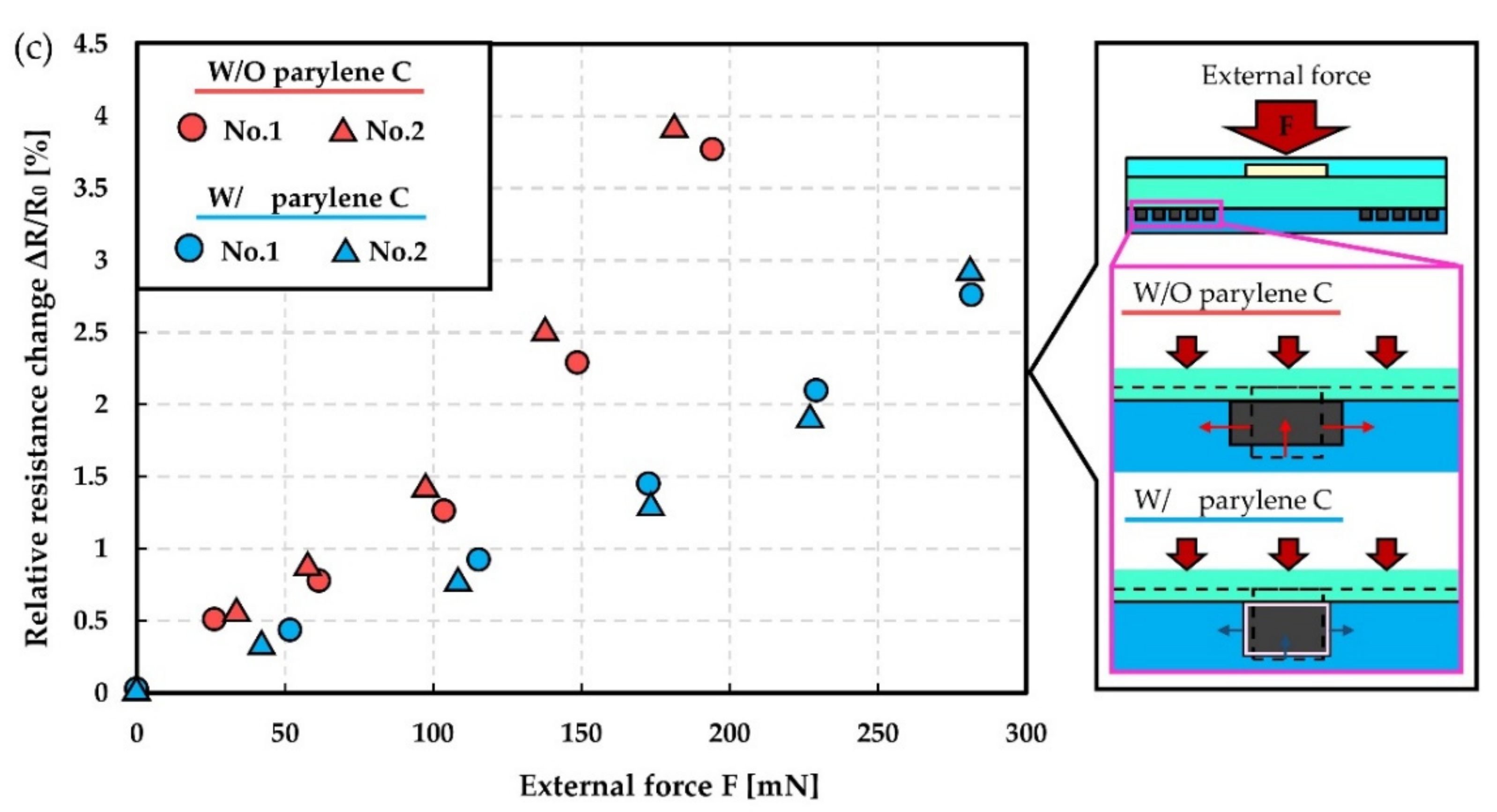
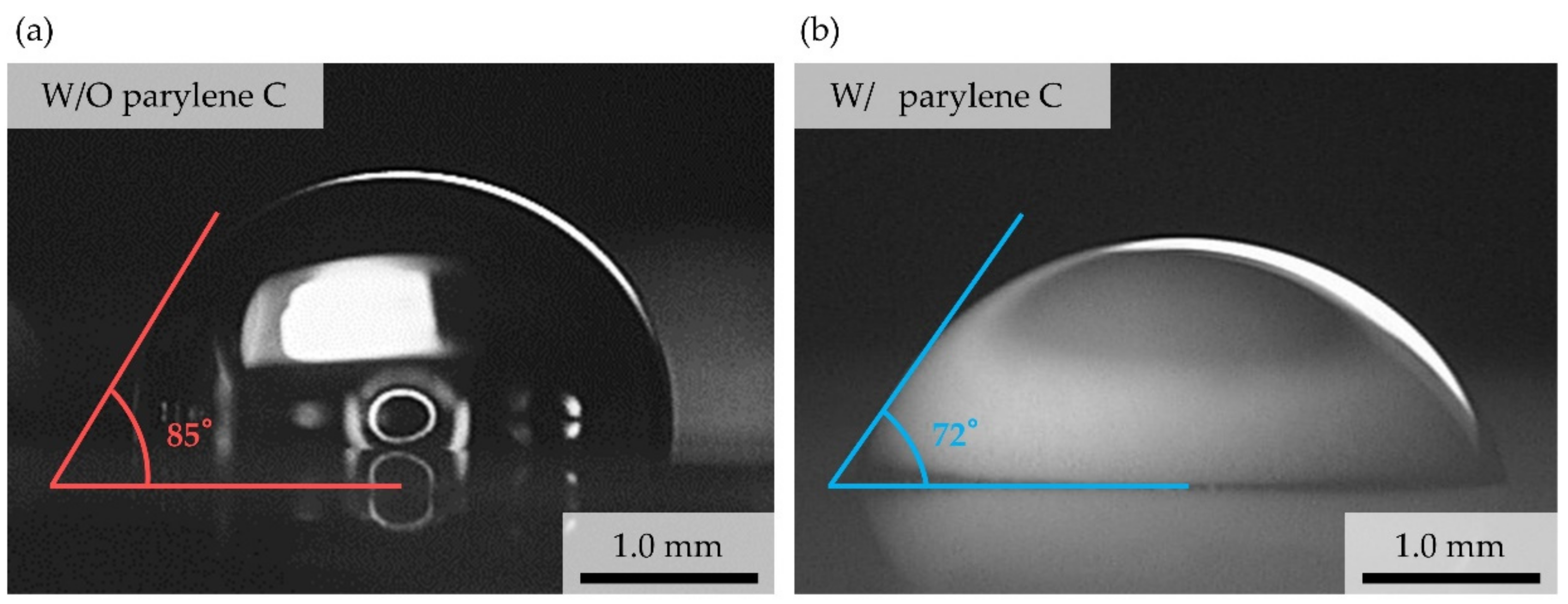
Publisher’s Note: MDPI stays neutral with regard to jurisdictional claims in published maps and institutional affiliations. |
© 2021 by the authors. Licensee MDPI, Basel, Switzerland. This article is an open access article distributed under the terms and conditions of the Creative Commons Attribution (CC BY) license (https://creativecommons.org/licenses/by/4.0/).
Share and Cite
Konishi, S.; Mori, F.; Shimizu, A.; Hirata, A. Structural Reinforcement Effect of a Flexible Strain Sensor Integrated with Pneumatic Balloon Actuators for Soft Microrobot Fingers. Micromachines 2021, 12, 395. https://doi.org/10.3390/mi12040395
Konishi S, Mori F, Shimizu A, Hirata A. Structural Reinforcement Effect of a Flexible Strain Sensor Integrated with Pneumatic Balloon Actuators for Soft Microrobot Fingers. Micromachines. 2021; 12(4):395. https://doi.org/10.3390/mi12040395
Chicago/Turabian StyleKonishi, Satoshi, Fuminari Mori, Ayano Shimizu, and Akiya Hirata. 2021. "Structural Reinforcement Effect of a Flexible Strain Sensor Integrated with Pneumatic Balloon Actuators for Soft Microrobot Fingers" Micromachines 12, no. 4: 395. https://doi.org/10.3390/mi12040395
APA StyleKonishi, S., Mori, F., Shimizu, A., & Hirata, A. (2021). Structural Reinforcement Effect of a Flexible Strain Sensor Integrated with Pneumatic Balloon Actuators for Soft Microrobot Fingers. Micromachines, 12(4), 395. https://doi.org/10.3390/mi12040395




